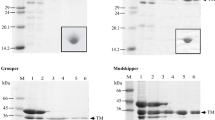Summary
Heavy meromyosin subfragment-1 (S1) was prepared by α-chymotrypsin from myosin of carp acclimated to either 10°C or 30°C for a minimum of 5 weeks. The objective of these studies was to document thermally-induced changes in the myosin molecule and to extend previous observations. Ca2+- and K+ (EDTA)-ATPase activities of cold-acclimated carp S1 were 1.1 and 0.8 μmol Pi·min-1·mg-1, respectively, and these values did not differ significantly from those of warm-acclimated carp. The inactivation rate constant (KD) of S1 from cold-acclimated carp was 32.1x10-4· s-1, compared to 13.2x10-4·s-1 for warm-acclimated carp. The maximum initial velocity of acto-S1 Mg2+-ATPase activity at pH 7.0 in 0.05 M KCl was 9.3 s-1 with cold-acclimated carp, about 3.7 times higher than that for warm-acclimated carp. However, no significant difference was observed in the apparent affinity of S1 to actin. Peptides maps of the heavy chain of S1 were different and suggested distinct isoforms for the myosins from warm- and cold-acclimated muscle.
Similar content being viewed by others
Abbreviations
- ATPase :
-
adenosine 5′-triphosphatase
- DTNB :
-
5,5′-dithiobis (2-nitrobenzoic acid)
- DTT :
-
dithiothreitol
- EDTA :
-
ethylenediaminetetraacetic acid
- EGTA :
-
ethyleneglycol bis (β-aminoethylether)-N,N,N′,N′-tetraacetic acid
- K D :
-
inactivation rate constant
- K m :
-
apparent dissociation constant
- P i :
-
inorganic γ-phosphate
- PMSF :
-
phenylmethane-sulfonyl fluoride
- S 1 :
-
heavy meromyosin subfragment-1
- SDS :
-
sodium dodecyl sulfate
- SDS-PAGE :
-
SDS-polyacrylamide gel electrophoresis
- TPCK :
-
N-tosyl-l-phenylalanyl chloromethyl ketone
- V max :
-
maximum initial velocity
References
Cleveland DW, Fischer SG, Kirschner MW, Laemmli UK (1977) Peptide mapping by limited proteolysis in sodium dodecyl sulfate and analysis by gel electrophoresis. J Biol Chem 252:1102–1106
Crockford T, Johnston IA (1990) Temperature acclimation and the expression of contractile protein isoforms in the skeletal muscles of the common carp (Cyprinus carpio L.). J Comp Physiol B 160:23–30
Fiske CH, Subbarow Y (1925) The colorimetric determination of phosphorus. J Biol Chem 66:375–400
Gazith J, Himmelfarb S, Harrington WF (1970) Studies on the subunit structure of myosin. J Biol Chem 245:15–22
Gornall AG, Bardawill CJ, David MM (1949) Determination of serum proteins by means of the biuret reaction. J Biol Chem 177:751–765
Guderley H, Blier P (1988) Thermal acclimation in fish conservative and labile properties of swimming muscle. Can J Zool 66:1105–1115
Hashimoto A, Kobayashi A, Arai K (1982) Thermostability of fish myofibrillar Ca-ATPase and adaptation to environmental temperatures. Bull Jpn Soc Sci Fish 48:671–684
Hazel JR, Prosser CL (1974) Molecular mechanisms of temperature compensation in poikilotherms. Physiol Rev 54:620–677
Heap SP, Watt PW, Goldspink G (1985) Consequences of thermal change on the myofibrillar ATPase of five freshwater teleosts. J Fish Biol 26:733–738
Hwang GC, Watabe S, Hashimoto K (1990) Changes of carp myosin ATPase induced by temperature acclimation. J Comp Physiol B 160:233–239
Johnston IA (1979) Calcium regulatory proteins and temperature acclimation of actomyosin ATPase from a eurythermal teleost (Carassius auratus L.). J Comp Physiol B 129:163–167
Johnston IA, Frearson N, Goldspink G (1973) The effects of environmental temperature on the properties of myofibrillar adenosine triphosphatase from various species of fish. Biochem J 133:735–738
Johnston IA, Davison W, Goldspink G (1975) Adaptation in Mg2+-activated myofibrillar ATPase activity induced by temperature acclimation. FEBS Lett 50:293–295
Johnston IA, Walesby NJ, Davison W, Goldspink G (1977) Further studies on the adaptation of fish myofibrillar ATPase to different cell temperatures. Pflügers Arch 371:257–262
Kishino A, Yanagida T (1988) Force measurements by micromanipulation of a single actin filament by glass needles. Nature 334:74–76
Laemmli UK (1970) Cleavage of structural proteins during the assembly of the head of bacteriophage T4. Nature 227:680–685
Oakley BR, Kirsch DR, Morris NR (1980) A simplified ultrasensitive silver stain for detecting proteins in polyacrylamide gels. Anal Biochem 105:361–363
Ochiai Y, Handa A, Kobayashi T, Watabe S, Hashimoto K (1989) Isolation and enzymatic properties of myosin subfragment 1 isozymes from the ordinary muscle of tilapia Oreochromis nilotiens. Bull Jpn Soc Sci Fish 55:2143–2149
Penney RK, Goldspink G (1981) Regulatory proteins and thermostability of myofibrillar ATPase in acclimated goldfish. Comp Biochem Physiol 69B:577–583
Spudich JA, Watt S (1971) The regulation of rabbit skeletal muscle contraction. J Biol Chem 246:4866–4871
Snedecor GW, Cochran WG (1980) Statistical methods. The Iowa State University Press, Iowa
Takiguchi K, Hayashi H, Kurimoto E, Higashi-Fujime S (1990) In vitro motility of skeletal muscle myosin and its proteolytic fragments. J Biochem 107:671–679
Tonomura Y (1972) Muscle proteins, muscle contraction and cation transport. University of Tokyo Press, Tokyo
Toyoshima YY, Stephen JK, McNally EM, Niebling KR, Toyoshima C, Spudich JA (1987) Myosin subfragment-1 is sufficient to move actin filaments in vitro. Nature 328:536–539
Watabe S, Ochiai Y, Hashimoto K (1982) Identification of 5,5′-dithio-bis-2-nitrobenzoic acid (DTNB) and alkali light chains of piscine myosin. Bull Jpn Soc Sci Fish 48:827–832
Watabe S, Hwang GC, Ushio H, Hashimoto K (1989) Biochemical responses to thermal acclimation in muscle proteins of carp. In: Miyachi S, Karube J, Ishida Y (eds) Current topics in marine biotechnology. Jpn Soc Mar Biotechnol, Tokyo, pp 323–326
Watabe S, Hwang GC, Ushio H, Hashimoto K (1990) Changes in rigor-mortis progress of carp induced by temperature acclimation. Agric Biol Chem 54:219–221
Weeds AG, Lowey S (1971) Substructure of the myosin molecule. II. The light chains of myosin. J Mol Biol 61:701–725
Weeds AG, Taylor RS (1975) Separation of subfragment-1 isoenzymes from rabbit skeletal muscle myosin. Nature 257:54–56
Yasui T, Kawakami H, Morita F (1968) Thermal inactivation of myosin A-adenosine triphosphatase in the presence of F-actin. Agric Biol Chem 32:225–233
Author information
Authors and Affiliations
Rights and permissions
About this article
Cite this article
Hwang, GC., Ochiai, Y., Watabe, S. et al. Changes of carp myosin subfragment-1 induced by temperature acclimation. J Comp Physiol B 161, 141–146 (1991). https://doi.org/10.1007/BF00262876
Received:
Issue Date:
DOI: https://doi.org/10.1007/BF00262876




